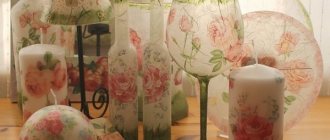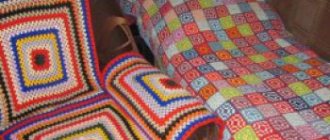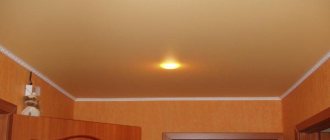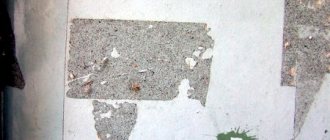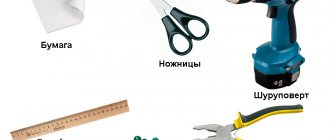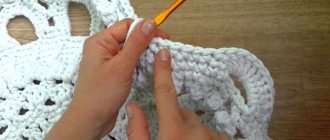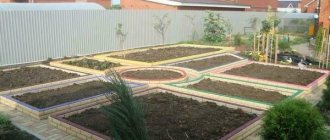We all periodically want to update the interior of our home and add coziness. When there are not enough resources for grandiose changes, cute little things come to the rescue - decorative pillows, blankets, rugs. Lately, knitted home decor has become the most popular. An original hand-made carpet can unite the interior of a room into a single whole. Even a novice needlewoman will be able to knit an original rug on her own, which will decorate the room and add color and texture to it. And besides this - additional pride of the hostess.
Which yarn to choose for knitting a rug
The beauty and practicality of the product will depend on how correctly the material for knitting is selected.
Before work, you need to decide on the size and texture of the future rug. Small canvases look good from:
- thick wool blend yarn. Experienced craftswomen note that yarn from Troitsk has performed well when knitting carpets. The products are incredibly soft and pleasant to the touch, and do not pill during use;
- pure acrylic. The main advantages of acrylic are that the products have dust-repellent properties and are easy to clean. In addition, acrylic knitted products do not deform after washing, do not fade, and have hypoallergenic properties;
- cotton threads. Ideal for creating openwork rugs. Such decorative elements are practical due to their light weight and are easy to care for.
Large knitted carpets look impressive if knitted from:
- knitting yarn. This is a relatively new material, which consists of long narrow ribbons of knitted fabric without knots or joints. Products made from such yarn look especially stylish in a modern interior;
- rope yarn (threads resembling lace or rope for macramé). May have different thicknesses and textures depending on the manufacturer. Well suited for dense products that require additional rigidity.
Many needlewomen choose textured yarn for knitting rugs: “grass”, threads with pom-poms, loops, bouclé and other interesting elements. In the Alize yarn line you can find threads with an unusual structure to suit every taste, bringing a wide variety of ideas to life.
Polyester cord for knitting carpets
Relatively recently, carpets and rugs began to be knitted from polyester cord. This is the same material from which the “Grand” and “Magnificent” carpets are knitted; many of you have probably heard such names. But of course any other products.
Despite the fact that this material is synthetic, it looks like natural, is soft to the touch, stretches well, is springy, does not fade, does not collect dust and does not become electrified.
It makes simply gorgeous carpets; rugs in the form of napkins, knitted according to the same patterns as openwork thin napkins, are especially popular. They can be laid in the most stylish interior in the living room. A carpet made from cord is voluminous and looks rich and elegant.
For knitting carpets, it is recommended to choose a polyester cord with a core, also called “cord in a cord”, with a diameter of 4.5-5 mm.
You can buy it in online stores; the range is now quite large and the color range is varied.
Consumption: for a rug with a diameter of one meter - approximately 600 meters of cord, for a rug with a diameter of two meters - 2000 m.
Recommended hook number is 7.
Disadvantages : Perhaps the only disadvantage of this material is its high cost: 2.5-2.8 rubles per meter.
Round mat for beginners
Materials and tools : knitting yarn 3-4 skeins, hook No. 9-12
Description of work:
- Knit 11 double crochets into the amigurumi ring (SS2H).
- Cast on three air loops (VP) of lifting, knit two CC2H into each column of the existing row.
- Three VPs, knit 2 CC2H into the first column of the previous row, and one CC2H into the second. Repeat this sequence of actions until the end of the row.
- Knit five VP lifts. In the second column of the connected row, knit one CC2H, cast on two VPs, knit one CC2H, skipping one column of the previous row. It should look like in the picture.
- Three VP lifts, tie the previous row with single crochet stitches (SS1H).
- Three VPs, in one column - two CC1H, in the other - one CC1H.
- The seventh row is knitted like the fourth (see point 4).
- The eighth row is knitted by analogy with the fifth (point 5).
- Three VP lifts, one CC1H in each loop of the previous row.
- The ninth row is knitted like the fourth and seventh.
- This row is worked like the fifth and eighth.
- Continue knitting until the diameter of the rug reaches the desired size.
- Last row: make one VP, put one single crochet in it, knit 6 CC1H into the third column of the previous row, then cast on two VP, skip two columns of the lower tier, knit six CC1H into the third. Continue to the end of the row.
Square rug
The “Granny Square” pattern is again at the peak of popularity. The rug looks stylish and modern in the interior.
Materials and tools : wool yarn in two folds, hook 4-5, needle for stitching. The rug will be of two colors - chocolate and beige.
Description of work:
- Cast on four VPs and close them into a circle using a connecting stitch (SS).
- Cast on five VPs, knit three CC1H into the circle, *two VPs, three CC1H to the ring*. Repeat the sequence from * to * two more times. The last time, knit not three CC1H, but two, since the third column is replaced by a chain from VP at the beginning of the row. We collect the end and beginning of knitting using SS.
- Cast on five VPs, knit three СС1Н into the first arch of the previous tier, then *one VP, into the next arch three СС1Н – two VP – three СС1Н*, repeat the sequence from * to * until the end of the row. At the end of the row SS.
- Cast on five VP, three СС1Н in the first arch, one VP, three СС1Н in the next arch, one VP, *three СС1Н - two VP - three СС1Н in the same arch* (** - this is how each corner of the square is knitted).
- Continue knitting as described in step 4 according to the pattern until the square becomes the desired size (another 3-4 rows).
- Knit the same square with the same color, and two squares with a different color.
- Fold the resulting four squares into one large one. The parts can be arranged in a checkerboard pattern and sewn with a needle. Tie the resulting large carpet with single crochets (3-5 rows). The color for the strapping is selected based on individual preferences.
Advantages and disadvantages of the method
Although DIY crochet floor rugs can complement any type of decor and create a beautiful look in your home, handmade products cannot completely replace regular rugs. Disadvantages include short-term use, the inability to wash the product, or problems with poor-quality base.
Often during use, threads begin to come out of the rugs or a lot of wool appears due to insufficiently dense knitting. Therefore, such products are used primarily as decorative elements to decorate and complement style.
The advantages of stylists include:
- Possibility to repeat the original version of the chosen concept (Japanese, European).
- Transforming unnecessary things from garbage into a real masterpiece with practical purpose and functionality.
- Original home decoration.
- Versatility of execution techniques. You can try yourself in different types and use different elements of work.
- Combination with other techniques (patchwork).
Do-it-yourself knitted rugs can warm you up during the cold season, decorate your home and add a touch of specialness to the room. And a skillful combination with other style elements will help create a real fairy tale in the house.
Oval rug
In order to thoroughly understand the principle of knitting ovals, a beginning needlewoman can practice on the simplest rug, consisting of double crochets. To make the rug more original, you can use several shades of yarn.
Materials and tools : 100% polyester yarn (lace), hook No. 3-4.
Description of work:
- Cast on a chain of 12 VPs.
- Cast on three VP lifts, knit one CC1H into the fourth loop, knit one CC1H into each VP until the end of the row. Knit six more CC1H into the last loop (it turns out to be a turn to the other side of the knitting). Now knit the entire row to the end with single crochets, starting from the first loop (in which six CC1H have just been knitted). Finish the row with six CC1H in the last loop and a connecting stitch.
- Three VP lifts and one CC1H in the same loop, then knit one CC1H in each loop. In the last loop before turning, knit two CC1H. Knit two CC1H into the next six stitches. Next, one CC1H in each loop of the previous tier. Also in the last loop before the turn - two SS1H, in the remaining loops - two SS1H, connect the row using SS.
- The remaining rows of the rug are knitted according to the same principle, according to the pattern.
Twine for knitting carpets
I recently talked about jute twine. This is an excellent natural material for stylish rugs.
We are talking specifically about jute rope, and no other rope, since only it will make a beautiful thing.
Knitting from jute is easy, and in order for a rug made from coarse rope to become soft and not fall off, it should be heat treated.
Jute thread and Karachay yarn are almost the same thickness, so it is convenient to combine and complement them with each other when knitting.
Disadvantages : when knitting with jute, it frays a lot and creates a lot of debris; it can cause a slight allergy.
Hexagon rug
A bright, original rug made of hexagonal motifs will be an excellent addition to a child's interior. You can choose any colors for the product, based on the shades of the walls, curtains, and furniture.
Materials and tools : Knitting yarn 3-4 skeins of different shades, hook No. 7-9, needle for stitching.
Description of work:
- Cast on a chain of five VPs, close them into a ring using a SS.
- Three VP rises, knit 11 СС1Н into the resulting ring, connect a row of SS.
- Three VP lifts (replace one CC1H), knit two CC2H into the next loop. The result is a group of three columns. Cast on *two VPs, in one loop of the previous row - one CC1H, in the second - two CC1H*. Continue knitting from * to * until the end of the row, ending knitting with a connecting stitch.
- Three VP rises, *over the SS1H of the previous row, knit the same double crochets, one SS1H in the arch, two VPs, 1 SS1H in the arch*. Continue knitting in the indicated sequence (from * to *) until the end of the row, SS.
- The fifth and sixth rows are knitted according to the description of the fourth. That is, double crochets are knitted above the columns of the previous row, one CC1H in the arch, two VP, one CC1H in the arch.
Knit 14 motifs of different colors, arrange them in the form of a rug, maintaining color balance. Sew the edges of the knitted elements into a single fabric. This form of the product does not require tying the edges; it looks interesting thanks to the color combination.
Product options and step-by-step knitting process
In stores you can find a variety of carpets for the home. They are made of different materials and have a variety of designs and patterns. There are knitted, cotton, woolen, multi-layer and other rugs on sale that can fit perfectly into any interior style. But handmade products have always been and will be valuable decorative elements that have a unique look.
You can make your own polyester or cotton mat in different shapes. To make it you need to use a hook, knitting needles or other special elements. But in this matter you cannot do without diagrams, templates, photos and knowledge of the basic rules.
Round or oval carpet
To make a round rug, it is recommended to select patterns and patterns for knitting. The process itself looks like this:
- Knitting a braided rug must include stitches.
- To knit the second row, you need to make two stitches from each loop.
- In the third, you need to add columns; they are increased through one loop.
- Next, add 2 loops and knit every two columns.
- In subsequent rows, the number of skipped loops increases.
For beginners, it is best to focus on the diagram. It is simple and understandable.
Making an oval rug is also not difficult. But in the end you can get a neat product with bright and beautiful patterns. The entire knitting process can be divided into several stages:
- to create a column of the required height using a hook or knitting needles, a series of air loops is cast on;
- then columns are knitted along the length of the chain of air loops;
- Posts are made at the ends, which will eventually be connected in one loop.
Round or oval rugs will fit perfectly into the living room or bedroom. They can be placed near the sofa, bed or armchairs. The soft surface and unusual pattern will bring warmth and comfort to the room.
Rectangular rug
Polyester, polyester, or cotton thread can be used as yarn for a rectangular rug. Laces should be used in different colors; it is better to combine them: purple with white, blue with pink, yellow with green.
The product is knitted step by step:
- A row of double crochets is knitted. After this, the work is turned over.
- Then a row of single crochets is made, the hook is placed under the front side of the loop. Everything is turning upside down.
- The third one is knitted in the same way as the second one. But the hook must be placed under both sides of the loop.
- The fourth is done in the same way as the second.
- The last row is made from double crochets under the far wall of the loop.
A rectangular rug is considered a universal product that can complement any room. You can create rugs of different sizes, which are laid out in the hallway, on the balcony, in the kitchen, in the hall.
Large rug: Tunisian knitting
The knitting of a Tunisian rug is simple, so you can easily reproduce it yourself. It is recommended to use thick woolen rope for the product; it will make the lace rug voluminous, soft and cozy. The carpet is created from individual fragments, which can be made from yarn of different colors. Then the flaps are stitched together. Step-by-step instruction:
- For knitting, it is recommended to use a long hook; use it to create a chain.
- Long loops are knitted from the air loops of the first row.
- All even-numbered rows must be fastened with the hook hooked to the working thread, which is passed through all the loops of the row.
